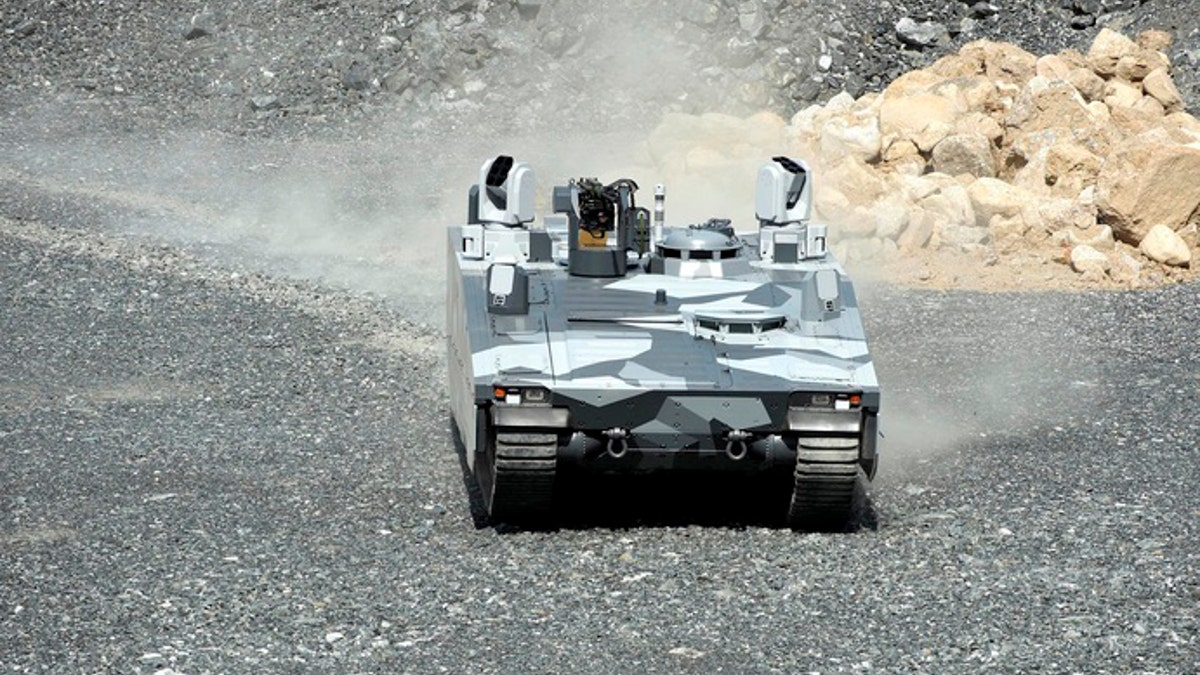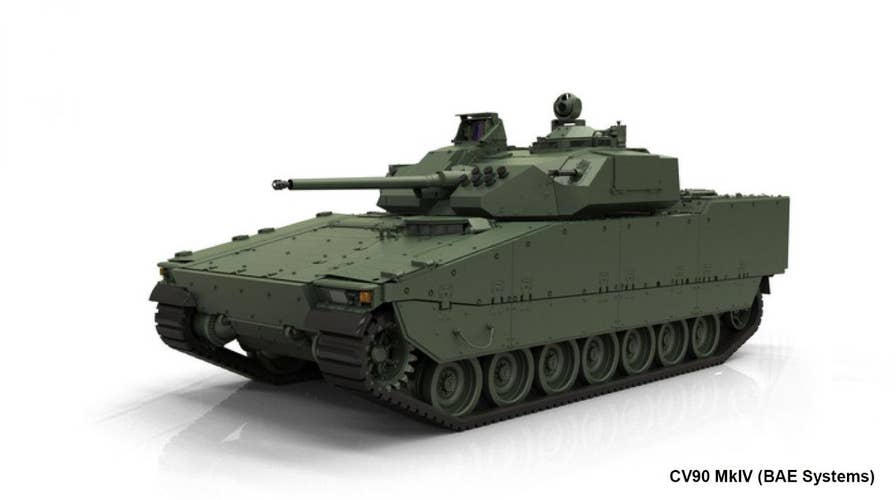‘Terminator’ tanks with ‘invisibility’ cloaking revealed
Fox Firepower: Defense Specialist Allison Barrie takes you behind the latest military technology that will allow BAE Systems' CV90 MkIV tank-like vehicle to potentially have an invisibility feature.
Imagine if the United States military could send combat vehicles like tanks into battle with enemies – but without a single American on the battlefield – instead, the vehicles drive and fight autonomously.
And what if these heavily armed and armored smart vehicles were also invisible to the enemy?
Now factor in this – these vehicles fire weapons powerful enough to destroy enemy aircraft, obliterate enemy tanks and level cities if necessary. The military machines could conduct entire battles while soldiers remotely control them safe from the hazards of battle at a great distance away.
Sounds wildly farfetched, right? Robot tanks conducting battles, invisible to the enemy, with armor that reacts to incoming fire – driven remotely by soldiers safely within bases on home soil.
This is not the stuff of the future – it is the innovation of now. The U.S. Army aims to have a Robotic Combat Vehicle demonstrator ready by 2021. Tech developed for this project should help to enable a generation of additional autonomous combat vehicles.
Similar to how drones are operated above war zones while flown by pilots more than an ocean away, smart heavily armed and armored vehicles could similarly execute the instructions of soldiers safely within the walls of a base.
NEW US NUCLEAR BOMBS AND FUTURISTIC STEALTH AIRCRAFT TO PROVIDE MIND-BOGGLING MILITARY MIGHT
Just like the aerial drones, the military will soon be able to remotely operate combat vehicles on the ground anywhere on the planet. Human crews operating the ground drones could be safely stationed on U.S. home soil – nowhere near the enemy.

CV90 variant (BAE Systems)
Here's a closer look at this breakthrough, extremely promising combat vehicle for dominating future battlespaces that keeps soldiers safe.
BAE’s Big Boy with Big Smarts
At the annual Association of the U.S. Army (AUSA) meeting in the nation’s capital this week, companies large and small from around the United States have brought their latest and greatest tech to showcase. With increased defense budget for next year and the Army’s modernization goals providing opportunities in several vital areas, companies are keen to rise to the challenge of meeting the Army’s requirements.
One exciting contender is BAE Systems’ CV90 MkIV tank-like vehicle displayed this week. The CV90 MkIV is very promising as a self-driving and self-fighting combat vehicle. And a potentially “invisible” one at that.
Will the U.S. Army be the first to tap this popular vehicle’s potential as a self-driving, self-shooting armed combat track rolling robot? Rather than a crew, will this be the tank-like vehicle that just one soldier can drive remotely using a simple handheld device?
The latest variant, the infantry fighting vehicle CV90 IV, already possesses “man-optional” combat mode. It offers all the advantages of the CV90, while potentially allowing a military to take humans out of the battle physically. BAE has already proven that it can remotely operate this ferocious machine beast.
PODCAST: “BLACK HAWK DOWN” 25th ANNIVERSARY – HEAR FIRSTHAND ABOUT WHAT HAPPENED AFTERWARDS
Armor
The standard-issue CV90 IV features advanced Active Protection System and crew protection from heavy weaponry including IEDs, anti-tank mines and Chemical, Biological, Radiological, and Nuclear (CBRN) attacks. Other armor options include protection against shaped charge warheads.
Invisibility
Get this – not only does this armored vehicle have the potential to conduct battle on its own in the future – but it also has the potential to be a smart, and ‘invisible,’ tank.
MEET THE NEW AIR FORCE HELICOPTERS THAT CAN 'DEFY ARMAGEDDON'
BAE’s mind-blowing and relentlessly trailblazing ADAPTIV program provides camouflage that renders the vehicle essentially “invisible” to enemy forces. It does this by something called “active multi-spectral cloaking.” The cloaking can make the vehicle blend into the background so it seems to vanish. It can even mimic other objects making the tank look like rocks or a car in the eyes of the enemy if need be.
Independent, Autonomous Defense
Another smarts option is the Defensive Aid Suite. This enables the armored vehicle to classify targets, give warnings about threats and best maneuver guidance to others in the battlespace. To prevent the vehicle from getting hit, it can also deploy countermeasures by itself.
Remote Controlled Firepower
One deployment option could be human crews operating inside the CV90 MkIV with the vehicle’s turret remotely controlled from elsewhere. Rather than having soldiers at risk in the turret, they could instead remotely fire the turret’s weaponry from inside the safety of a heavily fortified base at a great distance from the conflict – even from back in the USA while the rest of the crew is on the battlefield.
The CV90 tends to involve a two-man turret armed with Bushmaster cannons. This remote-controlled solution allows powerful weapons to be unleashed on the battlefield but reduces the risk to soldiers by taking them out of the turret.
The firepower is a pick and mix. The vehicle’s weaponry can be tailored to requirements and there’s quite a range of options – even very powerful missiles. The weapons can even defeat enemy aircraft and enemy tanks.
Its Fire Control System can already autonomously set the type of ammunition most suitable to defeat these threats, as well as automatically calculating the angles for maximum accuracy. By itself, the vehicle can also choose the fuse setting. This smart vehicle knows whether the best approach will be airburst, impact or delayed detonation and adjusts its selection to the threat.
PODCAST: GRENADE EXCHANGES + MORE UNFORGETTABLE GLIMPSES INSIDE LIFE AS A DELTA OPERATOR
How Could it be Used?
The flexibility smart combat vehicles provide will offer lots of advantages. Remote piloting from within the confines of a fortified base on U.S. home soil or abroad is just one.
$674 BILLION OF TANKS, FIGHTER JETS, SUBS AND MORE TO BOOST US MILITARY POWER IN 2019
In the long term, combat vehicles may conduct missions entirely on their own; however, simply because the capability exists does not mean that the Army will use it. It is very likely there will always be a human in the loop and the machines will not be permitted full autonomy. Longstanding aerial drone programs like the Reaper or Predator, and the military’s ongoing inclusion of talented remote human crews in their operation, is proof of how seriously the military takes keeping humans in the decision-making loop.
Rather than full autonomy involving machines without humans in the loop battling U.S. enemies in the battlespace, more likely scenarios involve clever use of the tech by soldiers themselves.
Soldiers could, for example, operate the unmanned CV90 MkIV combat vehicle while onboard another vehicle to amplify the force.
Dismounted soldiers could also control the unmanned vehicles, using them to perform reconnaissance in advance of troops.
Patrols, whether dismounted or in vehicles, could pilot the smart combat vehicles to travel in front of them so that in the event of an IED the unmanned vehicle would take the hit – potentially saving American lives.
In advance of the dismounted troops, the unmanned vehicles could attack enemy targets with soldiers harnessing the powerful weapons from a distance before entering the area themselves.
NEW LASER-EQUIPPED DRONES WILL TAKE OUT MISSILE THREATS AGAINST THE US
From inside a base, soldiers could also send the vehicles out on patrols either in autonomous mode or on a programmed route – prohibiting the CV90 MkIV from using its weapons and limiting it to simply following waypoints - as a show of force for peacekeeping. From within a base, the MkIVs could also be piloted on routine patrols of neighborhoods reducing soldiers’ fatigue, freeing them up for other tasks and enhancing readiness.
And of course, battalions of robotic combat vehicles could eventually be deployed in battles to deliver overwhelming firepower while American soldiers are a great distance from the fray.
But these are only just a few examples of the enormous potential breakthroughs.
Reducing Risk to Soldiers
In the future, the Army will have the option of sending both manned and unmanned ground combat vehicles against enemies. This will definitely come to pass – and within a mere three years if not faster.
Critics will fear monger about the sky falling due to this generation of smart combat vehicles. The fact that the military takes great care to keep humans in the decision-making process is frequently overlooked.
Most importantly, sending autonomous vehicles into combat without human crews could significantly reduce the risk of casualties.
'GIRAFFES' JOIN THE NAVY AND HUNT ENEMY THREATS
In addition to enemy attacks, soldiers in vehicles are regularly at serious risk from IEDs both on roads and off-road. Advances in armor have made a significant difference to force protection, but even tanks continue to be at risk from some enemy firepower.
If humans can be removed from the vehicles - and instead operate vehicles from a remote distance - then the danger to the lives of the vehicle crews is removed.
What’s Next?
For the vehicles to effectively drive, perform recon missions and fight by themselves in battle conditions, they must be able to master lots of complexities with extremely advanced tech.
From rapidly navigating obstacles and avoiding collisions through to maneuvering against enemies with human crews in battle, the advances to give these machines the necessary smarts are mind-boggling complex – but definitely achievable for the U.S. Army.

